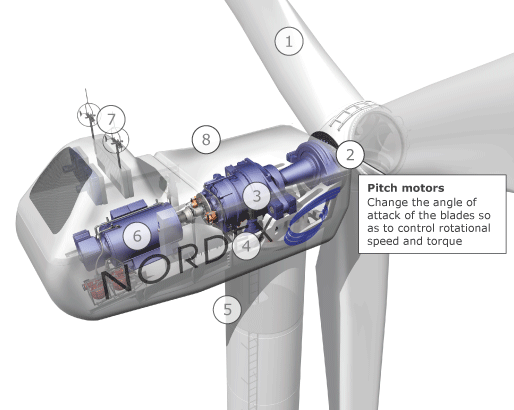Wind power density (WPD) is a calculation of the effective power of the wind at a particular location.A map showing the distribution of wind power density is a first step in identifying possible locations for wind turbines. In the United States, the National Renewable Energy Laboratory classifies wind power density into ascending classes. The larger the WPD at a location, the higher it is rated by class. Wind power classes 3 (300–400 W/m2 at 50 m altitude) to 7 (800–2000 W/m2 at 50 m altitude) are generally considered suitable for wind power development.There are 625,000 km2 in the contiguous United States that have class 3 or higher wind resources and which are within 10 km of electric transmission lines. If this area is fully utilized for wind power, it would produce power at the average continuous equivalent rate of 734 GWe. For comparison, in 2007 the US consumed electricity at an average rate of 474 GW, from a total generating capacity of 1,088 GW.
WPD = ½ * ρ * V3 (1)
And that air density can be determined to varying degrees of accuracy with the following.
Methods
1.) ρ = 1.225 kg/m3 (constant value based on U.S. Std. Atmosphere, at sea level)
2.) ρ = 1.225 - (1.194 * 10-4) * z (z=the location's elevation above sea level in m.)
3.) If you have pressure and temperature data:
ρ = P / RT (kg/m3)
where P = air pressure (in units of Pascals or Newtons/m2)
R = the specific gas constant (287 J kg-1 Kelvin-1)
T = air temperature in degrees Kelvin (deg. C + 273)
4.) If you have temperature data but not pressure data:
ρ = (Po / RT) * exp(-g*z/RT) (kg/m3)
where Po = std. sea level atmospheric pressure (101,325 Pascals)
g = the gravitational constant (9.8 m/s2); and
z = the region's elevation above sea level (in meters)
Wind Power Density Map
(Numerical Weather Prediction) modeling approach can be use to determining WPD map. Unlike traditional models that merely interpolate observed wind speeds between widely dispersed points, the interaction between the atmosphere and the earth's surface, to create a more robust and accurate wind climatology.
more information about map of wind power density can be found at 3TIER GIS
Wind Power Density Calculation method and example in detail also available in Oklahoma University, Just Download the document here
Estimates of wind power density are presented as wind class, ranging from 1 to 7. The speeds are average wind speeds over the course of a year,[8] although the frequency distribution of wind speed can provide different power densities for the same average wind speed














